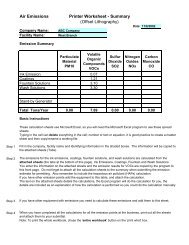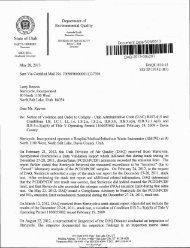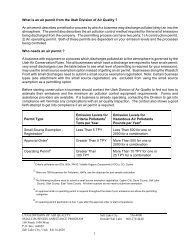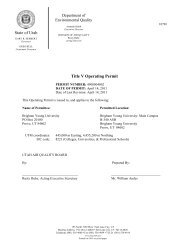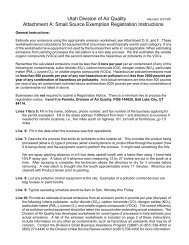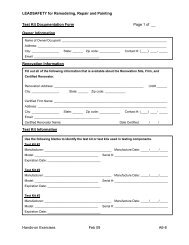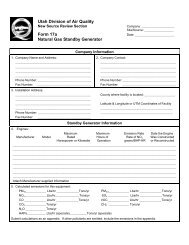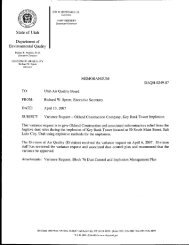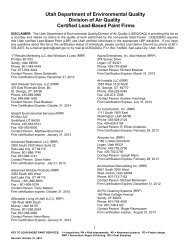State of Utah - Division of Air Quality - Utah.gov
State of Utah - Division of Air Quality - Utah.gov
State of Utah - Division of Air Quality - Utah.gov
You also want an ePaper? Increase the reach of your titles
YUMPU automatically turns print PDFs into web optimized ePapers that Google loves.
Department <strong>of</strong><br />
Environmental <strong>Quality</strong><br />
<strong>State</strong> <strong>of</strong> <strong>Utah</strong><br />
GARY R. HERBERT<br />
Governor<br />
Amanda Smith<br />
Executive Director<br />
DIVISION OF AIR QUALITY<br />
Rusty Ruby<br />
Acting Director<br />
GREG BELL<br />
Lieutenant Governor<br />
DAQE-AN0130310010-11<br />
May 4, 2011<br />
Bill Lawson<br />
PacifiCorp Energy<br />
1407 W. North Temple, Suite 310<br />
Salt Lake City, UT 84116<br />
Dear Mr. Lawson:<br />
Re:<br />
Approval Order: Installation <strong>of</strong> Lake Side Block #2 at PacifiCorp's Lake Side Power Plant<br />
Project Number: N013031-0010<br />
The attached document is the Approval Order for the above-referenced project. Future correspondence<br />
on this Approval Order should include the engineer's name as well as the DAQE number as shown on the<br />
upper right-hand corner <strong>of</strong> this letter. The project engineer for this action is John Jenks, who may be<br />
reached at (801) 536-4459.<br />
Sincerely,<br />
Rusty Ruby, Acting Executive Secretary<br />
<strong>Utah</strong> <strong>Air</strong> <strong>Quality</strong> Board<br />
RR:JJ:kw<br />
cc:<br />
Mike Owens<br />
<strong>Utah</strong> County Health Department<br />
195 North 1950 West • Salt Lake City, UT<br />
Mailing Address: P.O. Box 144820 • Salt Lake City, UT 84114-4820<br />
Telephone (801) 536-4000 • Fax (801) 536-4099 • T.D.D. (801) 536-4414<br />
www.deq.utah.<strong>gov</strong><br />
Printed on 100% recycled paper
STATE OF UTAH<br />
Department <strong>of</strong> Environmental <strong>Quality</strong><br />
<strong>Division</strong> <strong>of</strong> <strong>Air</strong> <strong>Quality</strong><br />
APPROVAL ORDER: Installation <strong>of</strong> Lake Side Block #2 at<br />
PacifiCorp's Lake Side Power Plant<br />
Prepared By: John Jenks, Engineer<br />
Phone: (801) 536-4459<br />
Email: jjenks@utah.<strong>gov</strong><br />
APPROVAL ORDER NUMBER<br />
DAQE-AN0130310010-11<br />
Date: May 4, 2011<br />
PacifiCorp Energy<br />
Lake Side Power Plant<br />
Source Contact:<br />
Mr. Bill Lawson<br />
Phone: (801) 220-4581<br />
Rusty Ruby<br />
Acting Executive Secretary<br />
<strong>Utah</strong> <strong>Air</strong> <strong>Quality</strong> Board
Abstract<br />
On September 24, 2008 PacifiCorp Energy (PacifiCorp) submitted a NOI to add a second generating<br />
block to the existing Lake Side Power Plant (LSPP) in <strong>Utah</strong> County. <strong>Utah</strong> County is a non-attainment<br />
area <strong>of</strong> the NAAQS for both PM 10 and PM 2.5 . The second generating block consists <strong>of</strong> two natural gasfired<br />
combustion turbines (CTs) with heat recovery steam generators (HRSGs), auxiliary boiler,<br />
emergency generator and cooling tower. Each CT/HRSG unit shall be equipped with a selective catalytic<br />
reduction (SCR) system and oxidation catalyst. Lake Side Block #2 is designed as a nominal 629 MW<br />
(rated at 52 degrees Fahrenheit) power plant that can operate independently from Lake Side Block #1.<br />
Lake Side Block #2 is subject to NSPS Subparts A, Dc, IIII and KKKK as well as NESHAP Subpart<br />
ZZZZ. Also, NESHAP Subpart YYYY applies although the provisions <strong>of</strong> this subpart are currently<br />
stayed for the types <strong>of</strong> CTs being installed at Block #2. The LSPP is defined as a major source under the<br />
Title V Operating Permit Program as well as being subject to Title IV <strong>of</strong> the CAA - Acid Rain Deposition<br />
Control Program. The proposed increases in potential emissions in TPY are as follows: PM 10 /PM 2.5<br />
+118.4, NO x +142.9, SO 2 +28.6, CO +588.6, VOC +97.7, and combined HAPs +15. All particulate<br />
emissions are considered PM 2.5 which is a subset <strong>of</strong> PM 10 . In addition, GHG emissions are expected to<br />
increase by 1,825,508 TPY CO 2 e. These emission increases result in this project being a PSD major<br />
modification for NO x , CO and GHG. This project is also a non-attainment area major modification for<br />
PM 10 and PM 2.5 . The combined PTE in TPY for the LSPP is: PM 10 /PM 2.5 = 215.4, NO x = 280.9, SO 2 =<br />
55.6, CO = 1139.6, VOC = 169.7 and combined HAPs = 27.4. As combined HAP emissions are greater<br />
than 25 TPY, the LSPP is a major HAP source under Title V. Total potential GHG emissions are<br />
estimated at 3,618,704 TPY CO 2 e.<br />
This source was required to obtain <strong>of</strong>fsets for the increase in emissions <strong>of</strong> PM 10 , PM 10 precursors, and<br />
PM 2.5 . With a required <strong>of</strong>fsetting ratio <strong>of</strong> 1.2:1 for PM 10 and PM 10 precursors, and 1:1 for PM 2.5 , the total<br />
amount <strong>of</strong> <strong>of</strong>fsets required was 142.08 tons <strong>of</strong> PM 10 , 171.48 tons <strong>of</strong> NO x , 34.32 tons <strong>of</strong> SO 2 and 118.4<br />
tons <strong>of</strong> PM 2.5 . The required amount <strong>of</strong> <strong>of</strong>fsets has been deducted from PacifiCorp’s banked emission<br />
credits.<br />
This air quality AO authorizes the project with the following conditions and failure to comply with any <strong>of</strong><br />
the conditions may constitute a violation <strong>of</strong> this order. This AO is issued to, and applies to the following:<br />
Name <strong>of</strong> Permittee:<br />
PacifiCorp Energy<br />
1407 W. North Temple, Suite 310<br />
Salt Lake City, UT 84116<br />
Permitted Location:<br />
Lake Side Power Plant<br />
1825 N Pioneer Lane<br />
Vineyard, UT 84058<br />
UTM coordinates: 436,000 m Easting, 4,464,500 m Northing, UTM Zone 12<br />
SIC code: 4911 (Electric Services)<br />
Section I: GENERAL PROVISIONS<br />
I.1 All definitions, terms, abbreviations, and references used in this AO conform to those used in<br />
the UAC R307 and 40 CFR. Unless noted otherwise, references cited in these AO conditions<br />
refer to those rules. [R307-101]
DAQE-AN0130310010-11<br />
Page 3<br />
I.2 The limits set forth in this AO shall not be exceeded without prior approval in accordance with<br />
R307-401. [R307-401]<br />
I.3 Modifications to the equipment or processes approved by this AO that could affect the<br />
emissions covered by this AO must be reviewed and approved. [R307-401-1]<br />
I.4 All records referenced in this AO or in other applicable rules, which are required to be kept by<br />
the owner/operator, shall be made available to the Executive Secretary or Executive Secretary's<br />
representative upon request, and the records shall include the five-year period prior to the date <strong>of</strong><br />
the request. Unless otherwise specified in this AO or in other applicable state and federal rules,<br />
records shall be kept for a minimum <strong>of</strong> five (5) years. [R307-415-6b]<br />
I.5 At all times, including periods <strong>of</strong> startup, shutdown, and malfunction, owners and operators<br />
shall, to the extent practicable, maintain and operate any equipment approved under this AO,<br />
including associated air pollution control equipment, in a manner consistent with good air<br />
pollution control practice for minimizing emissions. Determination <strong>of</strong> whether acceptable<br />
operating and maintenance procedures are being used will be based on information available to<br />
the Executive Secretary which may include, but is not limited to, monitoring results, opacity<br />
observations, review <strong>of</strong> operating and maintenance procedures, and inspection <strong>of</strong> the source.<br />
All maintenance performed on equipment authorized by this AO shall be recorded. [R307-401-<br />
4]<br />
I.6 The owner/operator shall comply with UAC R307-150 Series. Inventories, Testing and<br />
Monitoring. [R307-150]<br />
Section II: SPECIAL PROVISIONS<br />
II.A<br />
II.A.1<br />
The approved installations shall consist <strong>of</strong> the following equipment:<br />
Lake Side Power Plant<br />
Permitted Source<br />
II.A.2 CT #1 and #2<br />
Two (2) natural gas-fired dry low-NO x , combined cycle turbines, each with 150 foot stack (as<br />
measured from the base <strong>of</strong> the stack)<br />
II.A.3 HRSG #1 and #2<br />
Two (2) Heat Recovery Steam Generators, each equipped with low NO x duct burner - 184<br />
MMBtu/hr<br />
II.A.4<br />
II.A.5<br />
Block #1 SCR<br />
Two (2) Selective Catalytic Reduction (SCR) systems with ammonia injection, one for each<br />
turbine/HRSG set<br />
Block #1 CO Catalysts<br />
Two (2) CO catalysts, one for each turbine/HRSG set
DAQE-AN0130310010-11<br />
Page 4<br />
II.A.6<br />
Block #1 Steam Turbine<br />
One (1) steam turbine<br />
II.A.7 Auxiliary Boiler #1<br />
One (1) natural gas-fired 61.2 MMBtu/hr auxiliary boiler with 50 ft. boiler stack (as<br />
measured from the base <strong>of</strong> the stack)<br />
II.A.8 Cooling Tower #1<br />
One (1) 10 Cell mechanical draft evaporative cooling tower with drift elimination<br />
II.A.9 CT #3 and #4<br />
Two (2) natural gas-fired dry low-NO x , combined cycle turbines, each with 150 foot stack (as<br />
measured from the base <strong>of</strong> the stack)<br />
II.A.10 HRSG #3 and #4<br />
Two (2) Heat Recovery Steam Generators, each equipped with low NO x duct burner<br />
approximately 400 MMBtu/hr<br />
II.A.11<br />
II.A.12<br />
II.A.13<br />
Block #2 SCR<br />
Two (2) Selective Catalytic Reduction (SCR) systems with ammonia injection, one for each<br />
turbine/HRSG set<br />
Block #2 CO Catalysts<br />
Two (2) CO catalysts, one for each turbine/HRSG set<br />
Block #2 Steam Turbine<br />
One (1) steam turbine<br />
II.A.14 Auxiliary Boiler #2<br />
One (1) natural gas-fired 61.2 MMBtu/hr auxiliary boiler with 60 ft. boiler stack (as<br />
measured from the base <strong>of</strong> the stack)<br />
II.A.15 Cooling Tower #2<br />
One (1) 16 Cell mechanical draft evaporative cooling tower with drift elimination<br />
II.A.16<br />
II.A.17<br />
II.A.18<br />
II.A.19<br />
II.A.20<br />
Fuel Dew Point Heater<br />
One (1) 3.67 MMBtu/hr fuel dew point heater<br />
Emergency Generator<br />
Two (2) approximately 1,500 hp diesel-fired emergency generators<br />
Fire Pump<br />
One (1) 290 hp diesel-fired fire pump<br />
Water Treatment<br />
Water treatment and storage facilities<br />
Ammonia Storage and Handling<br />
Aqueous ammonia storage and handling equipment
DAQE-AN0130310010-11<br />
Page 5<br />
II.A.21<br />
Miscellaneous Equipment<br />
CT lube oil vent system, maintenance shop vent system, machining and welding operations,<br />
etc.<br />
II.A.22 Lake Side Block #1<br />
Lake Side Block #1 consists <strong>of</strong> CT #1 and #2, associated HRSGs, control equipment,<br />
auxiliary boiler and cooling tower: includes Block #1 CO Catalysts, Auxiliary Boiler #1, CT<br />
#1 and #2, Block #1 Steam Turbine, HRSG #1 and #2, Block #1 SCR, Cooling Tower #1<br />
II.A.23 Lake Side Block #2<br />
Lake Side Block #2 consists <strong>of</strong> CT #3 and #4, associated HRSGs, control equipment,<br />
auxiliary boiler and cooling tower: includes HRSG #3 and #4, Block #2 CO Catalysts, CT #3<br />
and #4, Block #2 Steam Turbine, Cooling Tower #2, Block #2 SCR, Auxiliary Boiler #2<br />
II.A.24<br />
II.B<br />
II.B.1<br />
II.B.1.a<br />
Additional Equipment<br />
Fuel treatment, fire suppression, water treatment, ammonia storage and other misc.<br />
equipment: includes Emergency Generator, Fire Pump, Ammonia Storage and Handling,<br />
Miscellaneous Equipment, Water Treatment, Fuel Dew Point Heater<br />
Requirements and Limitations<br />
Conditions on Permitted Source<br />
PacifiCorp shall notify the Executive Secretary in writing when the installation <strong>of</strong> the<br />
equipment listed in II.A.23 has been completed and is operational, as an initial compliance<br />
inspection is required. To insure proper credit when notifying the Executive Secretary, send<br />
your correspondence to the Executive Secretary, attn: Compliance Section.<br />
If construction and/or installation has not been completed within eighteen months from the<br />
date <strong>of</strong> this AO, the Executive Secretary shall be notified in writing on the status <strong>of</strong> the<br />
construction and/or installation. At that time, the Executive Secretary shall require<br />
documentation <strong>of</strong> the continuous construction and/or installation <strong>of</strong> the operation and may<br />
revoke the AO. [R307-401-11]<br />
II.B.1.b<br />
The owner/operator shall install, calibrate, maintain, and operate a continuous emissions<br />
monitoring system on each <strong>of</strong> the HRSG stacks. The owner/operator shall record the NO x and<br />
CO emissions. The monitoring system shall comply with all applicable sections <strong>of</strong> R307-170;<br />
40 CFR 13; and 40 CFR 60, Appendix B. The NO x monitor shall comply with 40 CFR 75,<br />
Appendix A and B.<br />
All continuous emissions monitoring devices as required in federal regulations and state rules<br />
shall be installed prior to placing the affected source in operation. These devices shall be<br />
certified within 90 days <strong>of</strong> achieving full load, not to exceed 180 days after startup.<br />
Except for system breakdown, repairs, calibration checks, and zero and span adjustments<br />
required under paragraph (d) 40 CFR 60.13, the owner/operator <strong>of</strong> an affected source shall<br />
continuously operate all required continuous monitoring systems and shall meet minimum<br />
frequency <strong>of</strong> operation requirements as outlined in R307-170 and 40 CFR 60.13. [R307-170]
DAQE-AN0130310010-11<br />
Page 6<br />
II.B.1.c<br />
Visible emissions shall not exceed the following values:<br />
All natural gas combustion exhaust stacks - 10% opacity<br />
All other emission points - 20% opacity<br />
Opacity observations <strong>of</strong> emissions from stationary sources shall be conducted according to 40<br />
CFR 60, Appendix A, Method 9. [R307-401-8]<br />
II.B.2 Conditions on Lake Side Block #1<br />
II.B.2.a<br />
II.B.2.b<br />
The owner/operator shall use natural gas as fuel in the combustion turbines, duct burners and<br />
auxiliary boiler. [R307-401-8]<br />
Emissions to the atmosphere from the indicated emission point(s) shall not exceed the<br />
following rates and concentrations:<br />
Source: Auxiliary Boiler #1<br />
Pollutant Limitations Averaging Period<br />
PM 10 0.01 lb/MMBtu 3-hour<br />
NO x 0.017 lb/MMBtu 3-hour<br />
CO 0.037 lb/MMBtu 3-hour<br />
Source: Each Turbine/HRSG Stack (at Block #1)<br />
Pollutant Limitations Averaging Period<br />
PM 10 10.8 lb/hour (0.01 lb/MMBtu) 30-day rolling average<br />
NO x 2.0 ppmvd at 15% O 2 (14.9 lb/hr)* 3-hour<br />
CO 3.0 ppmvd at 15% O 2 (14.1 lb/hr)* 3-hour<br />
* Under steady state operation.<br />
[R307-401-8]<br />
II.B.2.c<br />
Stack testing to show compliance with the emission limitations stated in the above condition<br />
shall be performed as specified below:<br />
Emissions Point Pollutant Status Frequency<br />
HRSG Stacks PM 10 * $<br />
NO x * #<br />
CO * #<br />
Auxiliary Boilers PM 10 * %<br />
NO x * %<br />
CO * %<br />
Testing Status (To be applied to the sources listed above)
DAQE-AN0130310010-11<br />
Page 7<br />
* Initial compliance testing has been completed. If an existing source is modified, a<br />
compliance test is required on the modified emission point that has an emission rate limit.<br />
$ Test every year or testing may be replaced with parametric monitoring if approved by the<br />
Executive Secretary<br />
% Test every five (5) years or testing may be replaced with parametric monitoring if approved<br />
by the Executive Secretary<br />
# Compliance shall be demonstrated through use <strong>of</strong> a Continuous Emissions Monitoring<br />
System (CEM) as outlined in Condition II.B.1.c. The Executive Secretary may require testing<br />
at any time.<br />
[R307-165]<br />
II.B.2.d<br />
For all emissions testing the following shall apply:<br />
Notification:<br />
The Executive Secretary shall be notified at least 30 days prior to conducting any required<br />
emission testing. A source test protocol shall be submitted to DAQ when the testing<br />
notification is submitted to the Executive Secretary.<br />
The source test protocol shall be approved by the Executive Secretary prior to performing the<br />
test(s). The source test protocol shall outline the proposed test methodologies, stack to be<br />
tested, and procedures to be used. A pretest conference shall be held, if directed by the<br />
Executive Secretary.<br />
Sample Location:<br />
The emission point shall be designed to conform to the requirements <strong>of</strong> 40 CFR 60, Appendix<br />
A, Method 1, or other methods as approved by the Executive Secretary. An Occupational<br />
Safety and Health Administration (OSHA) or Mine Safety and Health Administration<br />
(MSHA) approved access shall be provided to the test location.<br />
Volumetric Flow Rate:<br />
40 CFR 60, Appendix A, Method 2 or EPA Test Method No. 19 "SO 2 Removal & PM, SO 2 ,<br />
NO x Rates from Electric Utility Steam Generators" or other testing methods approved by the<br />
Executive Secretary.<br />
PM 10 :<br />
For stacks in which no liquid drops are present, the following methods shall be used: 40 CFR<br />
51, Appendix M, Methods 201, 201a and 202, or other testing methods approved by the<br />
Executive Secretary. All particulate captured shall be considered PM 10 . The back half<br />
condensibles shall be used for compliance demonstration as well as for inventory purposes.<br />
For stacks in which liquid drops are present, methods to eliminate the liquid drops should be
DAQE-AN0130310010-11<br />
Page 8<br />
explored. If no reasonable method to eliminate the drops exists, then the following methods<br />
shall be used: 40 CFR 60, Appendix A, Method 5, 5a, 5d, or 5e as appropriate, or other testing<br />
methods approved by the Executive Secretary. The back half condensibles shall also be tested<br />
using the method specified by the Executive Secretary. The portion <strong>of</strong> the front half <strong>of</strong> the<br />
catch considered PM 10 shall be based on information in Appendix B <strong>of</strong> the fifth edition <strong>of</strong> the<br />
EPA document, AP-42, or other data acceptable to the Executive Secretary.<br />
NO x :<br />
40 CFR 60, Appendix A, Method 7, 7A, 7B, 7C, 7D, 7E, or other testing methods approved by<br />
the Executive Secretary.<br />
CO:<br />
40 CFR 60, Appendix A, Method 10, or other testing methods approved by the Executive<br />
Secretary.<br />
Calculations:<br />
To determine mass emission rates (lb/hr, etc.) the pollutant concentration as determined by the<br />
appropriate methods above shall be multiplied by the volumetric flow rate and any necessary<br />
conversion factors determined by the Executive Secretary, to give the results in the specified<br />
units <strong>of</strong> the emission limitation.<br />
[R307-165]<br />
II.B.2.e<br />
Compliance with the 3-hour NO x and CO emission limitations specified in Condition II.B.2.b<br />
shall not be required during short-term excursions, limited to a cumulative total <strong>of</strong> 160 hours<br />
per rolling 12-month period. Short-term excursions are defined as 15-minute periods<br />
designated by the Owner/Operator that are the direct result <strong>of</strong> transient load conditions, not to<br />
exceed four consecutive 15-minute periods, when the 15-minute average NO x and CO<br />
concentrations exceed 2.0 ppmv and 3.0 ppmv, dry @ 15% O 2 , respectively. Transient load<br />
conditions include the following:<br />
1. Initiation/shutdown <strong>of</strong> combustion turbine inlet air-cooling<br />
2. Rapid combustion turbine load changes<br />
3. Initiation/shutdown <strong>of</strong> HRSG duct burners<br />
4. Provision <strong>of</strong> Ancillary Services and Automatic Generation Control<br />
During periods <strong>of</strong> transient load conditions, the NO x concentration shall not exceed 25 ppmv<br />
and the CO concentration shall not exceed 50 ppmv, dry @ 15% O 2 . All NO x and CO<br />
emissions during these events shall be included in all calculations <strong>of</strong> annual mass emissions as<br />
required by this permit. [R307-401-8]<br />
II.B.2.f<br />
Steady state operation means all periods <strong>of</strong> combustion turbine operation, except for periods <strong>of</strong><br />
startup and shutdown as defined below, and periods <strong>of</strong> transient load conditions as defined in<br />
Condition II.B.2.e. Startup is defined as the period beginning with turbine initial firing until<br />
the unit meets the ppmvd emission limits in the first table <strong>of</strong> Condition II.B.2.b for steady state<br />
operation. Shutdown is defined as the period beginning with the initiation <strong>of</strong> turbine shutdown
DAQE-AN0130310010-11<br />
Page 9<br />
sequence and ending with the cessation <strong>of</strong> firing <strong>of</strong> the gas turbine engine. Startup and<br />
shutdown events shall not exceed 613.5 hours per turbine per rolling 12-month period and are<br />
counted toward the applicable annual emission limitations. Total startup and shutdown events<br />
shall not exceed 14-hours per turbine in any one calendar day, commencing at midnight.<br />
Emissions during startup and shutdown periods shall be counted toward the applicable annual<br />
emission limitations. [R307-401-8]<br />
II.B.3 Conditions on Lake Side Block #2<br />
II.B.3.a<br />
II.B.3.b<br />
The owner/operator shall use natural gas as fuel in the combustion turbines, duct burners and<br />
auxiliary boiler. [R307-401-8]<br />
Emissions to the atmosphere from the indicated emission point(s) shall not exceed the<br />
following rates and concentrations:<br />
Source: Auxiliary Boiler #2<br />
Pollutant Limitations Averaging Period<br />
PM 10 /PM 2.5 0.01 lb/MMBtu 3-hour<br />
NO x 0.017 lb/MMBtu 3-hour<br />
CO 0.037 lb/MMBtu 3-hour<br />
VOC 0.006 lb/MMBtu 3-hour<br />
Source: Each Turbine/HRSG Stack (at Block #2)<br />
Pollutant Limitations Averaging Period<br />
PM 10 /PM 2.5 14 lb/hour (with duct firing) 30-day rolling average<br />
NO x 2.0 ppmvd at 15% O 2 (18.1 lb/hr)* 3-hour<br />
CO 3.0 ppmvd at 15% O 2 (16.6 lb/hr)* 3-hour<br />
VOC 2.8 ppmvd at 15% O 2 * 3-hour<br />
* Under steady state operation.<br />
[R307-401-8]<br />
II.B.3.c<br />
Stack testing to show compliance with the emission limitations stated in the above condition<br />
shall be performed as specified below:<br />
Emissions Point Pollutant Status Frequency<br />
HRSG Stacks PM 10 /PM 2.5 * $<br />
NO x * #<br />
CO * #<br />
VOC * &<br />
Auxiliary Boilers PM 10 /PM 2.5 * %<br />
NO x * %<br />
CO * %<br />
VOC * %
DAQE-AN0130310010-11<br />
Page 10<br />
Testing Status (To be applied to the sources listed above)<br />
* Initial compliance testing is required. The initial test date shall be performed as soon as<br />
possible and in no case later than 180 days after the start up <strong>of</strong> a new emission source, an<br />
existing source without an AO, or the granting <strong>of</strong> an AO to an existing emission source that<br />
has not had an initial compliance test performed. If an existing source is modified, a<br />
compliance test is required on the modified emission point that has an emission rate limit.<br />
$ Test every year or testing may be replaced with parametric monitoring if approved by the<br />
Executive Secretary<br />
& Test every two (2) years or testing may be replaced with parametric monitoring if approved<br />
by the Executive Secretary<br />
% Test every five (5) years or testing may be replaced with parametric monitoring if approved<br />
by the Executive Secretary<br />
# Compliance shall be demonstrated through use <strong>of</strong> a Continuous Emissions Monitoring<br />
System (CEM) as outlined in Condition II.B.1.c. The Executive Secretary may require testing<br />
at any time.<br />
[R307-165]<br />
II.B.3.d<br />
For all emissions testing the following shall apply:<br />
Notification:<br />
The Executive Secretary shall be notified at least 30 days prior to conducting any required<br />
emission testing. A source test protocol shall be submitted to DAQ when the testing<br />
notification is submitted to the Executive Secretary.<br />
The source test protocol shall be approved by the Executive Secretary prior to performing the<br />
test(s). The source test protocol shall outline the proposed test methodologies, stack to be<br />
tested, and procedures to be used. A pretest conference shall be held, if directed by the<br />
Executive Secretary.<br />
Sample Location:<br />
The emission point shall be designed to conform to the requirements <strong>of</strong> 40 CFR 60, Appendix<br />
A, Method 1, or other methods as approved by the Executive Secretary. An Occupational<br />
Safety and Health Administration (OSHA) or Mine Safety and Health Administration<br />
(MSHA) approved access shall be provided to the test location.<br />
Volumetric Flow Rate:<br />
40 CFR 60, Appendix A, Method 2 or EPA Test Method No. 19 "SO 2 Removal & PM, SO 2 ,<br />
NO x Rates from Electric Utility Steam Generators" or other testing methods approved by the<br />
Executive Secretary.
DAQE-AN0130310010-11<br />
Page 11<br />
PM 10 /PM 2.5 :<br />
For stacks in which no liquid drops are present, the following methods shall be used: 40 CFR<br />
51, Appendix M, Methods 201, 201a and 202, or other testing methods approved by the<br />
Executive Secretary. All particulate captured shall be considered PM 10 /PM 2.5 . The back half<br />
condensibles shall be used for compliance demonstration as well as for inventory purposes.<br />
For stacks in which liquid drops are present, methods to eliminate the liquid drops should be<br />
explored. If no reasonable method to eliminate the drops exists, then the following methods<br />
shall be used: 40 CFR 60, Appendix A, Method 5, 5a, 5d, or 5e as appropriate, or other testing<br />
methods approved by the Executive Secretary. The back half condensibles shall also be tested<br />
using the method specified by the Executive Secretary. The portion <strong>of</strong> the front half <strong>of</strong> the<br />
catch considered PM 10 /PM 2.5 shall be based on information in Appendix B <strong>of</strong> the fifth edition<br />
<strong>of</strong> the EPA document, AP-42, or other data acceptable to the Executive Secretary.<br />
NO x :<br />
40 CFR 60, Appendix A, Method 7, 7A, 7B, 7C, 7D, 7E, or other testing methods approved by<br />
the Executive Secretary.<br />
CO:<br />
40 CFR 60, Appendix A, Method 10, or other testing methods approved by the Executive<br />
Secretary.<br />
Calculations:<br />
To determine mass emission rates (lb/hr, etc.) the pollutant concentration as determined by the<br />
appropriate methods above shall be multiplied by the volumetric flow rate and any necessary<br />
conversion factors determined by the Executive Secretary, to give the results in the specified<br />
units <strong>of</strong> the emission limitation.<br />
[R307-165]<br />
II.B.3.e<br />
Compliance with the 3-hour NO x and CO emission limitations specified in Condition II.B.3.b<br />
shall not be required during short-term excursions, limited to a cumulative total <strong>of</strong> 160 hours<br />
per rolling 12-month period. Short-term excursions are defined as 15-minute periods<br />
designated by the Owner/Operator that are the direct result <strong>of</strong> transient load conditions, not to<br />
exceed four consecutive 15-minute periods, when the 15-minute average NO x and CO<br />
concentrations exceed 2.0 ppmv and 3.0 ppmv, dry @ 15% O 2 , respectively. Transient load<br />
conditions include the following:<br />
1. Initiation/shutdown <strong>of</strong> combustion turbine inlet air-cooling<br />
2. Rapid combustion turbine load changes<br />
3. Initiation/shutdown <strong>of</strong> HRSG duct burners<br />
4. Provision <strong>of</strong> Ancillary Services and Automatic Generation Control<br />
During periods <strong>of</strong> transient load conditions, the NO x concentration shall not exceed 25 ppmv<br />
and the CO concentration shall not exceed 50 ppmv, dry @ 15% O 2 . All NO x and CO
DAQE-AN0130310010-11<br />
Page 12<br />
emissions during these events shall be included in all calculations <strong>of</strong> annual mass emissions as<br />
required by this permit. [R307-401-8]<br />
II.B.3.f<br />
Steady state operation means all periods <strong>of</strong> combustion turbine operation, except for periods <strong>of</strong><br />
startup and shutdown as defined below, and periods <strong>of</strong> transient load conditions as defined in<br />
Condition II.B.3.e. Startup is defined as the period beginning with turbine initial firing until<br />
the unit meets the ppmvd emission limits in the first table <strong>of</strong> Condition II.B.3.b for steady state<br />
operation. Shutdown is defined as the period beginning with the initiation <strong>of</strong> turbine shutdown<br />
sequence and ending with the cessation <strong>of</strong> firing <strong>of</strong> the gas turbine engine. Startup and<br />
shutdown events shall not exceed 553.6 hours per turbine per rolling 12-month period. Total<br />
startup and shutdown events shall not exceed 8 hours per turbine in any one calendar day,<br />
commencing at midnight.<br />
Emissions <strong>of</strong> NO x from either Block #2 CT/HRSG unit (CT #3 or #4) shall not exceed 130<br />
lb/hr during startup or shutdown operations.<br />
Emissions <strong>of</strong> CO from either Block #2 CT/HRSG unit (CT #3 or #4) shall not exceed 3,000<br />
lb/hr during startup or shutdown operations. [R307-401-8]<br />
II.B.3.g<br />
II.B.4<br />
II.B.4.a<br />
II.B.4.b<br />
Total CO 2 e emissions from Lake Side Block 2 shall not exceed 950 lb/MWh(g) on a 12-month<br />
rolling average basis. Hourly heat input for each turbine and the HSRG will be obtained from<br />
the data submitted to the Acid Rain database and summed over the appropriate 12-month<br />
period. This total heat input will then be multiplied by an emission factor <strong>of</strong> 121.723 lb<br />
CO 2 e/MMBtu to obtain the total CO 2 e emissions during the 12-month period. The 12-month<br />
gross generation for each turbine and HSRG will be obtained from the data reported to the<br />
Acid Rain database. This hourly generation will be summed over the twelve-month period to<br />
obtain the total gross generation. The CO 2 e per MWh(g) value is calculated by dividing the<br />
12-month total CO 2 e emissions by the 12-month total gross generation. [R307-401-8]<br />
Conditions on Additional Equipment<br />
Emergency generators shall be used for electricity producing operation only during the periods<br />
when electric power from the public utilities is interrupted, and for regular maintenance and<br />
testing. Records documenting generator usage shall be kept in a log and they shall show the<br />
date the generator was used, the duration in hours <strong>of</strong> the generator usage, and the reason for<br />
each generator usage. [R307-401-8]<br />
The owner/operator shall use a combination <strong>of</strong> #1 or #2 fuel oil or diesel fuel in the emergency<br />
generators and fire pump.<br />
The sulfur content <strong>of</strong> any #2 fuel oil or diesel fuel burned shall not exceed 0.0015 percent by<br />
weight. Sulfur content shall be determined by ASTM Method D-4294-89, or approved<br />
equivalent. Certification <strong>of</strong> fuels shall be either by the owner/operator's own testing or test<br />
reports from the fuel marketer or supplier. For purposes <strong>of</strong> demonstrating compliance with<br />
this limitation, the owner/operator may obtain the above specifications by testing each<br />
purchase <strong>of</strong> fuel in accordance with the required methods; by inspection <strong>of</strong> the specifications<br />
provided by the vendor for each purchase <strong>of</strong> fuel; or by inspection <strong>of</strong> summary documentation<br />
<strong>of</strong> the fuel sulfur content from the vendor; provided that the above specifications are available<br />
from the vendor for each purchase if requested. [R307-401-8]
DAQE-AN0130310010-11<br />
Page 13<br />
Section III: APPLICABLE FEDERAL REQUIREMENTS<br />
In addition to the requirements <strong>of</strong> this AO, all applicable provisions <strong>of</strong> the following federal programs<br />
have been found to apply to this installation. This AO in no way releases the owner or operator from any<br />
liability for compliance with all other applicable federal, state, and local regulations including UAC<br />
R307.<br />
NSPS (Part 60), KKKK: Stationary Combustion Turbines<br />
NSPS (Part 60), IIII: Stationary Comp/Ignit R.I.C.E<br />
NSPS (Part 60), GG: Stationary Gas Turbines<br />
MACT (Part 63), ZZZZ: Recipro. Int. Comb Engine (RICE)<br />
Title IV (Part 72 / Acid Rain), (No subparts)<br />
MACT (Part 63), YYYY: Stationary Combustion Turbines<br />
NSPS (Part 60), Dc: Small Indus Com InstitnSteamGenratr<br />
NSPS (Part 60), Db: Indus Com Institn Steam Generator<br />
NSPS (Part 60), A: General Provisions<br />
This AO is based on the following documents:<br />
PERMIT HISTORY<br />
Incorporates Additional Information Received dated November 8, 2010<br />
Incorporates Additional Information Received dated October 12, 2010<br />
Incorporates Additional Information Received dated August 31, 2010<br />
Incorporates Additional Information Received dated August 26, 2010<br />
Incorporates Additional Information Received dated August 19, 2010<br />
Incorporates Additional Information Received dated August 12, 2010<br />
Incorporates Additional Information Received dated August 4, 2010<br />
Incorporates Additional Information Received dated August 2, 2010<br />
Incorporates Additional Information Received dated July 6, 2010<br />
Incorporates Additional Information Received dated June 24, 2010<br />
Incorporates Additional Information Received dated June 14, 2010<br />
Incorporates Additional Information Received dated June 9, 2010<br />
Incorporates Additional Information Received dated May 28, 2010<br />
Incorporates Additional Information Received dated May 26, 2010<br />
Incorporates Additional Information Received dated May 25, 2010<br />
Incorporates Additional Information Received dated December 7, 2009<br />
Incorporates Additional Information Received dated October 29, 2009<br />
Incorporates Additional Information Received dated July 16, 2009<br />
Incorporates Additional Information Received dated May 13, 2009<br />
Incorporates Additional Information Received dated January 28, 2009<br />
Incorporates Additional Information Received dated January 12, 2009<br />
Incorporates Additional Information Received dated December 8, 2008<br />
Incorporates Additional Information Received dated November 5, 2008<br />
Is Derived From Source submitted NOI dated September 24, 2008<br />
Supersedes DAQE-AN0130310006-07 dated December 10, 2007
DAQE-AN0130310010-11<br />
Page 14<br />
ADMINISTRATIVE CODING<br />
The following information is for UDAQ internal classification use only:<br />
<strong>Utah</strong> County<br />
CDS A<br />
MACT (Part 63), Major HAP source, NSPS (Part 60), NSR, Nonattainment or Maintenance Area, PSD,<br />
Title IV (Part 72 / Acid Rain), Title V (Part 70), Title V (Part 70) Major source
DAQE-AN0130310010-11<br />
Page 15<br />
ACRONYMS<br />
The following lists commonly used acronyms and associated translations as they apply to this<br />
document:<br />
40 CFR Title 40 <strong>of</strong> the Code <strong>of</strong> Federal Regulations<br />
AO<br />
Approval Order<br />
BACT<br />
Best Available Control Technology<br />
CAA<br />
Clean <strong>Air</strong> Act<br />
CAAA<br />
Clean <strong>Air</strong> Act Amendments<br />
CDS<br />
Classification Data System (used by EPA to classify sources by size/type)<br />
CEM<br />
Continuous emissions monitor<br />
CEMS<br />
Continuous emissions monitoring system<br />
CFR<br />
Code <strong>of</strong> Federal Regulations<br />
CO<br />
Carbon monoxide<br />
CO 2<br />
Carbon Dioxide<br />
CO 2 e Carbon Dioxide Equivalent - 40 CFR Part 98, Subpart A, Table A-1<br />
COM<br />
Continuous opacity monitor<br />
DAQ<br />
<strong>Division</strong> <strong>of</strong> <strong>Air</strong> <strong>Quality</strong> (typically interchangeable with UDAQ)<br />
DAQE<br />
This is a document tracking code for internal UDAQ use<br />
EPA<br />
Environmental Protection Agency<br />
GHG<br />
Greenhouse Gas(es) - 40 CFR 52.21 (b)(49)(i)<br />
GWP<br />
Global Warming Potential - 40 CFR Part 86.1818-12(a)<br />
HAP or HAPs Hazardous air pollutant(s)<br />
ITA<br />
Intent to Approve<br />
LB/HR Pounds per hour<br />
MACT Maximum Achievable Control Technology<br />
MMBTU Million British Thermal Units<br />
MWh (g) Mega watt hours (gross)<br />
NAA<br />
Nonattainment Area<br />
NAAQS National Ambient <strong>Air</strong> <strong>Quality</strong> Standards<br />
NESHAP National Emission Standards for Hazardous <strong>Air</strong> Pollutants<br />
NOI<br />
Notice <strong>of</strong> Intent<br />
NO x<br />
Oxides <strong>of</strong> nitrogen<br />
NSPS<br />
New Source Performance Standard<br />
NSR<br />
New Source Review<br />
PM 10<br />
Particulate matter less than 10 microns in size<br />
PM 2.5<br />
Particulate matter less than 2.5 microns in size<br />
PSD<br />
Prevention <strong>of</strong> Significant Deterioration<br />
PTE<br />
Potential to Emit<br />
R307 Rules Series 307<br />
R307-401 Rules Series 307 - Section 401<br />
SO 2<br />
Sulfur dioxide<br />
Title IV Title IV <strong>of</strong> the Clean <strong>Air</strong> Act<br />
Title V<br />
Title V <strong>of</strong> the Clean <strong>Air</strong> Act<br />
TPY<br />
Tons per year<br />
UAC<br />
<strong>Utah</strong> Administrative Code<br />
UDAQ <strong>Utah</strong> <strong>Division</strong> <strong>of</strong> <strong>Air</strong> <strong>Quality</strong> (typically interchangeable with DAQ)<br />
VOC<br />
Volatile organic compounds
DAQE-AN0130310010-11<br />
Page 16



